#Neak Pean
Explore tagged Tumblr posts
Text
王道の大回りルート
2日目。大回りルートです。 まずは宿の近くのランドリー。 カンボジアでは1ドル4,000リエルで計算されるのですが、ここのランドリーは洗濯物1㎏で6,000リエル(1.5ドル)。 この日の洗濯物は3.5㎏なので195,000リエル。 5ドル(20,000リエル)払って5,000リエルのお釣りをもらう、もしくは 4ドル(16,000リエル)と3,500リエルを払う、 と、支払いに頭の体操が必要になるのがちょっと面倒。 朝食は近くのおしゃれカフェっぽいところへ。 フルーツパンケーキをたのんだら、彩り鮮やかな&女子力高めのプレートが出てきました。。。これが今のカンボジアなのね。 さて、今日は大回りルート。 Prasat Kravan プラサット・クラヴァン(Prasat Kravan)は921年にハルシャヴァルマン 1 世(Harshavarman I : 在位…
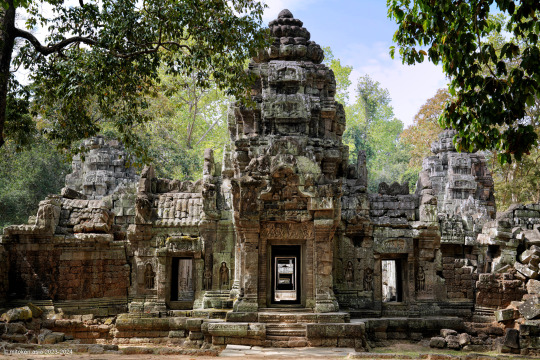
View On WordPress
0 notes
Text
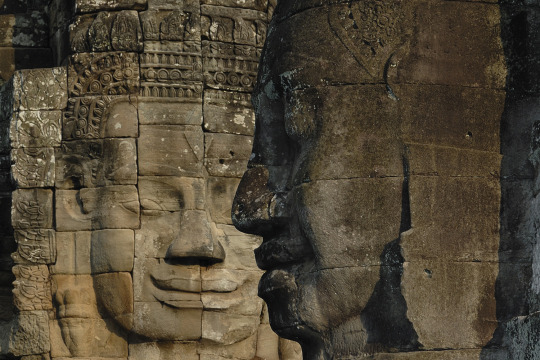
Excerpts:
"After decades of turmoil, in 1181 Jayavarman VII restored order to the Angkor Empire by embracing Buddhism and introducing an unprecedented public healthcare programme."
He suffered the illnesses of his subjects more than his own; because it is the pain of the public that is the pain of kings rather than their own pain.
So reads a 12th-century stele, marking the foundation of a hospital temple near the banks of the Mekong River. The same words were inscribed at multiple hospital temples across the vast Angkorian Empire, which, at its height in the 11th and 12th centuries, covered most of South-east Asia from its centre at Angkor, in present-day Cambodia. The inscription refers to Jayavarman VII, the first Buddhist king of Angkor."
---
"Along with this central ‘hospital’ temple, inscriptions state that Jayavarman VII founded an additional 102 hospitals. These were probably open to all, although how such care was paid for is unknown. People may have had to make a donation, but it is possible that healthcare was offered without charge. Each hospital would have contained a shrine to Bhaisajyaguru, the Buddha of medicine and healing. Before entering Buddhahood, Bhaisajyaguru made a vow to help the physical and mental health of all living beings. The hospital edicts state that just hearing the name Bhaisajyaguru was enough to cure all ills."
In addition to ritual and spiritual healthcare, these hospitals also offered healing in a manner more akin to ‘modern’ medicine. The inscriptions give an inventory of staff and supplies. Each hospital was home to achar – priests – and a large team of medical workers, including two doctors, two apothecaries, eight nurses and six assistants. There were also guards, cooks, rice-makers and servants. The medical team offered diagnostic testing, most likely by reading the pulse." ...
"The hospitals also prescribed medicines, including honey, butter, oil and molasses. It is highly probable that medical alchemy formed a large part of the healthcare service at Angkor. An inscription at Ta Prohm temple lists royal donations of metals and apparatus that would have been used for alchemy, including mercury sulfide and a gold cauldron." ...
"Evidence of these medical practices are found in the diary of Zhou Daguan, a Chinese envoy who visited Angkor in the 13th century. In his vivid account of daily life at Angkor, he wrote that mercury and sulphur were imported from China. He also recorded that people cured disease by ‘plunging into water and repeatedly washing the head’, the kind of curative treatment perhaps offered at Neak Pean." ...
A more recent article:
---
The world's first public health-care system was created in what is now Cambodia over 800 years ago. The USA still doesn't have one, and the UK's is being destroyed by its government. Many other countries lack any kind of reliable healthcare.
And the effectiveness of the Khmer healthcare isn't the point. They did the best they could with the knowledge they had at the time.
5 notes
·
View notes
Text
Tant d'émotions furent vécues en cette journée. Si vous devez vous en contenter d'une, choisissez celle ci : le bonheur orgasmique d'un gâteau au chocolat pour un Dr Rathatton en manque ...

Sinon, ce matin, on a refait des nouveaux temples, un peu plus rapidement qu'hier si l'on veut être honnête. C'est très joli, mais à la 12eme porte avec trois visages gravés dans la pierre, 165eme mètre de fresque antique, et 2823eme Aspara (danseuse des Dieux) gravée dans les murs, on y prête un peu moins attention. Ce qui ne nous a pas empêché de nous émerveiller sur ces raretés archéologiques !

A noter que sur nos billets, il était écrit que ce très joli temple ouvrait à 5h du matin (il n'y en a que 4 avec cette opportunité, les autres ouvrent à 7h30). Nous nous réveillons donc le sourire aux lèvres à 5h40 et partons la fleur au fusil assister à un lever de soleil tardif sur cette oeuvre d'art. Voici le résultat :

(bon, on a quand même eu des jolies couleurs depuis l'extérieur)

Dans les temples notables, le Neak Pean, construit au milieu d'un lac (créé par un roi d'ailleurs, ils ne faisaient rien à moitié à cette époque), et qui représente le lac sacré Anavatapta. C'est de ce lac que s'écoulent 4 cours d'eau (notamment le Gange), symbolisés par 4 bassins de rétention sur les côtés.


On retrouve quelques temples dévorés par la végétation (chapeau bas aux travaux de restauration d'ailleurs, c'est impressionnant)



Et une fois nos mirettes comblées, notre après midi sera consacré à... La sieste (c'est plus des valises sous les yeux, c'est des sacs de randonnée), la piscine, et les cartes postales !

3 notes
·
View notes
Text
Today’s visit the Grand tour circuit! Preah Khan temple, Neak Pean temple, Ta Sam temple, Est Mebon temple & Pre Rup temple
One Day Tour, Siem Reap Private Taxi, Cambodia Taxi Drivers please kindly check our website www.siemreapprivatetaxi.com / chat WhatsApp +85569467474 / email [email protected]
#taxi service#siemreaptaxidriver#templestour#cambodiaholiday#onedaytour#cambodiatrips#tour#travel#transfer#angkortours
1 note
·
View note
Text
Discover the Ancient Mysteries of Cambodia with Our Vietnam Tour Packages
Embark on a captivating journey through Cambodia's rich history and pristine landscapes with our Cambodia Tour Packages. Start in Siem Reap, exploring Wat Bo pagoda's stunning Ramayan paintings and learning traditional crafts at "Les Artisans d'Angkor – Chantiers Ecole." Shop at the bustling Psar Char market and take a wooden boat through the Chong Kneas Floating Village on Tonle Sap Lake. The highlight is the majestic Angkor Wat, a UNESCO World Heritage Site, with its intricate temples like Bayon, Terrace of Elephants, Preak Khan, and Neak Pean. Pair this adventure with our Vietnam Tour Packages for an unforgettable Southeast Asian experience.
0 notes
Text
Siem Reap Temples: The Ultimate Guide
Get ready for a magical mystery tour of the Siem Reap temples, where the ancient monuments of Angkor stand as monumental testaments to Cambodia's rich history and spiritual depth. In this guide with take a no-nonsense approach to getting the best from your visit to the enchanting world of the Siem Reap's templesThis post may contain affiliate links to things like hotels, tours or products. These help us earn a small commission at no additional charge to you and help keep the lights on at Destination Someplace.
Making The Most of Your Time at The Siem Reap Temples
Embarking on a journey to explore the Siem Reap temples is an adventure that deserves thoughtful planning to fully appreciate the diversity of this archaeological wonderland. The duration of your visit can significantly influence your experience, allowing for either a fleeting glimpse or an in-depth exploration of these historical marvels.
Ideal Visit Durations for a Great Experience
For a truly immersive experience, consider allocating different lengths of time based on your schedule and interests:Short Stay (1-2 days): Ideal for travellers with limited time, focusing primarily on the iconic Angkor Wat, Bayon, and Ta Prohm. This duration offers a snapshot of the temples' grandeur but limits deeper exploration.Medium Stay (3-5 days): A more balanced option, allowing you to explore the key highlights and several lesser-known temples. This duration provides a richer understanding of the architectural and cultural nuances.Long Stay (6+ days): For the ardent explorers, a longer stay enables a deep dive into the history and artistry of numerous temples, including remote sites, and offers opportunities for repeat visits to favourite spots at different times of the day.

Me and Mrs A outside Ankgor Wat
Suggestions for Short, Medium, and Long Stays
Short Stay: Prioritize sunrise at Angkor Wat, the enigmatic faces of Bayon, and the tree-root enshrouded Ta Prohm. These iconic sites offer a condensed yet powerful experience of Siem Reap's temple heritage.Medium Stay: Expand your itinerary to include Banteay Srei, known for its intricate carvings, and the grand circuit temples like Preah Khan and Neak Pean. Consider an early morning or late afternoon visit to avoid crowds and experience the temples in different lighting.Long Stay: Delve into the outskirts to uncover gems like Beng Mealea and Koh Ker. Dedicate time to revisit your favourites, exploring them at a leisurely pace to appreciate their beauty and tranquillity fully.

Ankgor Wat
Tips on Prioritizing Temples Based on Interests and Time Constraints
Research Ahead: Familiarise yourself with the history and significance of each temple to align your itinerary with your interests, whether they are architectural, historical, or spiritual.Consult Local Experts: Guides and guided tours can provide insights into the best times to visit specific temples and suggest itineraries that maximize your experience based on current conditions and interests.Stay Flexible: Be prepared to adjust your plans based on weather, crowds, or spontaneous discoveries. Sometimes, the most memorable experiences arise from unexpected detours or moments of quiet reflection in less visited corners of the temple complex.In optimizing your visit to Siem Reap's temples, balancing structured planning with the openness to discovery can lead to a truly enriching and memorable experience.
Transportation Tips: Navigating Siem Reap and Angkor
Navigating the majestic landscapes of Siem Reap and the grand Angkor temple complex is an integral part of your adventure. Here's how you can make the most of your transportation options, ensuring a smooth and respectful journey through this sacred land. Variety of Transportation Options: Siem Reap offers a diverse array of transport modes tailored to every traveller’s preference and budget. From the Cambodian versions of tuk-tuks (or remork-moto - which is basically a large trailer hitched to a motorcycle) and bicycles to more modern options like taxis and e-bikes, you can choose your ideal way to explore the temples at your own pace. For those seeking a deeper connection with the environment, cycling offers an eco-friendly way to traverse the temple grounds, providing a serene and intimate experience. Meanwhile, tuk-tuks (or rather, remork-motos) remain a quintessential part of the Cambodian travel experience, offering a local and flexible mode of transport.Recommendations for Reliable and Convenient Transport: For convenience and reliability, consider arranging your transportation through reputable companies, a specialist tour or your accommodation provider. Booking in advance can often secure you a knowledgeable and trustworthy driver, who can not only navigate the complex with ease but also share insights into the temples and local culture. If opting for a tuk-tuk or taxi, ensure that your vehicle is in good condition and agree on the fare or rental rate in advance to avoid any misunderstandings.Safety Tips and Cultural Etiquette: When using local transportation, always prioritize safety and respect local customs. Wear helmets if cycling or riding motorbikes, and secure your belongings, especially in open vehicles like tuk-tuks. Be mindful of local etiquette, such as removing your shoes when entering certain temple areas and dressing modestly out of respect for the cultural and spiritual significance of the sites. Remember, your transportation choices not only affect your experience but also contribute to the local economy and environment, so choose wisely and respectfully.

Nuture takes over at Ta Prohm Temple
Ticket Essentials: Your Pass to Siem Reap's Wonders
Discovering the architectural magnificence of Siem Reap's temples starts with securing the right ticket. Understanding the available options ensures you make the most of your visit while respecting the heritage and preservation efforts of these ancient sites.Ticket Types and Benefits: Siem Reap offers several ticket types to cater to varying durations and interests. The most common are 1-day, 3-day, and 7-day passes, each allowing ample time to explore at your own pace. Longer tickets provide the flexibility to visit during different times of the day, capturing the temples in varying lights and avoiding peak crowds.Purchasing Process: Tickets can be purchased at the official Angkor ticket centre, located near the entrance to the temple complex. To avoid long queues, especially during peak tourist season, arrive early or consider purchasing later in the day for use the following day. Ensure you bring a valid ID (passport is ideal) as it may be required during purchase and at temple checkpoints, please note you will also have your photograph taken for your temple pass.Maximizing Value and Avoiding Pitfalls: To get the best value, plan your visit according to the ticket duration—don't rush through sites just to "get your money's worth." Respect the cultural and natural setting by following guidelines and disposing of waste properly. Be wary of unofficial ticket sellers and always verify the authenticity of your pass to prevent any inconveniences during your temple exploration.
Travel Guide: Reaching Siem Reap and Angkor Wat
Embarking on your journey to the majestic Siem Reap and its awe-inspiring temples involves navigating various travel options, each offering a unique perspective of the region's landscape and culture.Travel Options to Siem Reap: Visitors can reach Siem Reap by air, land, or water. The new Siem Reap–Angkor International Airport, which opened in 2023, welcomes flights from many major cities, providing a convenient entry point, but please note your transfer time from the airport to the Siem Reap itself will take about 50 mins by car. Overland routes include bus or car travel from neighbouring countries like Thailand and Vietnam, and offer scenic views along the way. Alternatively, more adventurous travellers might consider a boat trip along the Tonle Sap Lake, providing a serene approach to the city.International Access and Connections: Siem Reap's airport facilitates direct and connecting flights from across the globe, making it an accessible destination for international travellers. Key regional hubs like Bangkok, Singapore, and Kuala Lumpur offer frequent connections, easing the journey to this historic locale.Tips for Smooth Travel and Entry: Ensure your passport is valid for at least six months beyond your travel date and check visa requirements based on your nationality. E-visas can simplify the entry process and are recommended for their convenience. Upon arrival, be prepared to navigate customs and immigration, respecting all local regulations. To enhance your travel experience, consider learning a few basic Khmer phrases and familiarize yourself with Cambodian customs, demonstrating respect and appreciation for the local culture as you begin your exploration of Siem Reap's wonders.
Need Flights?

Elephant Terrace
Where to Stay in Siem Reap
Finding the perfect place to stay in Siem Reap can significantly enhance your temple exploration experience, offering comfort and convenience after a day of adventure.Accommodation Recommendations: Siem Reap boasts a wide range of accommodation to suit every budget and preference. Luxury seekers can find opulent hotels with spa services and fine dining, while budget travellers have numerous guesthouses and hostels offering clean, affordable rooms. For convenience, choose a stay near the Angkor complex or the vibrant city centre. Consider amenities like free Wi-Fi, pool access, and on-site dining when making your selection. On our recent visit, we stayed at the serene Amber Ankgor Villa and Spa, just a short distance from the centre of Siem Reap and with a very relaxing pool area, ideal for cooling off with a beer or a cocktail after a hard day's temple hunting.Unique Lodging Experiences: Enhance your temple visit with accommodations that offer a touch of Cambodian culture or unique experiences. Boutique hotels often feature traditional Khmer architecture and art, providing an immersive cultural experience. Eco-lodges and farm stays offer insight into local life and sustainable tourism practices.Booking Tips and Peak Season Advice: To secure your ideal accommodation, book well in advance, especially during peak season (November to February). Compare prices and read reviews on trusted travel sites. Consider the timing of your visit; while the dry season offers comfortable temple exploration, the wet season can provide lush landscapes and fewer tourists. Remember to check for flexible cancellation policies and confirm your booking closer to your travel date to avoid any issues.

Evening, the pool at Amber Ankgor Villa and Spa

Wall carving Siem Reap Temples
Top Tips for Exploring Siem Reap Temples
Delving into the spiritual and architectural grandeur of Siem Reap's temples is a profound experience that demands thoughtful preparation and respect for the ancient heritage.Best Times to Visit: To avoid the crowds and experience the temples in relative solitude, consider visiting during the early morning or late afternoon. Specific temples, like Angkor Wat, are renowned for their sunrise views, so plan to arrive early to secure a good spot. Conversely, temples like Ta Prohm or Banteay Srei offer serene beauty during the late afternoon when the light accentuates their intricate carvings.Respectful Behaviour and Attire: Demonstrating respect at these sacred sites is paramount. Dress modestly, covering shoulders and knees, and remove hats and sunglasses when entering temple sanctuaries. Speak softly, and avoid disruptive behaviour. Remember that these are places of worship and cultural significance for many Cambodians.Enhancing the Experience: To truly connect with the history and spirituality of the temples, consider hiring a knowledgeable local guide or join a tour that can provide insights into the site's history, architecture, and religious significance. Take time to pause and absorb the atmosphere, perhaps meditating or simply sitting in quiet contemplation. Respect the sites by not touching the carvings or climbing on fragile structures, and always carry water and sun protection to ensure a comfortable and enriching exploration.Look After Yourself: Ensure you take, or your tour/tour guide provides water for your exploration of the temples, don’t underestimate how quickly you can de-hydrate. Also ensure that you lather on the sunscreen to protect against sunburn and UV damage, absolutely essential in this part of the world, also pack a hat for shade and protection, especially if your hair is a distant memory – like mine! Finally, don’t forget mosquito repellent, the little beasties will be most active in the mornings and the evenings, so make sure you spray before catching those epic sunrises and sunsets.Be aware that the ground around these ancient temples can be uneven and unpredictable, and especially at Ankgor Wat there are some very steep stairs to ascend to the top of the temple, therefore flip-flops are not advised, instead wear something more robust such as trainers when exploring the ruins.

Exploring the Siem Reap Temples complex
Top Ten Temples in Siem Reap
The temple complex of Siem Reap is a treasure trove of ancient wonders, each temple offering a unique window into the past. While Angkor Wat steals the spotlight, numerous other temples in the area promise equally fascinating experiences with their distinctive histories and architectural features.Angkor Wat: The crown jewel of Angkor, known for its grand scale and intricate bas-reliefs, represents the epitome of Khmer architecture.Bayon: Famous for its serene stone faces gazing across the land, Bayon stands at the heart of Angkor Thom, offering a mysterious and captivating allure.Ta Read the full article
0 notes
Text
youtube
ប្រាសាទនាគពន្ធ័ | Neak Pean Temple | Neak Pean Temple Cambodia
0 notes
Text


La visite se poursuit a Pre Rup, immense pyramide de brique qui permet de dominer le site.


Vient ensuite To Som avec tour d’entrée aux 4 visages.



Puis le bucolique temple de Neak Pean au milieu des bassins.



Et pour finir, Preah Khan, immense, où trône le temple de l’épée sacrée.
1 note
·
View note
Text
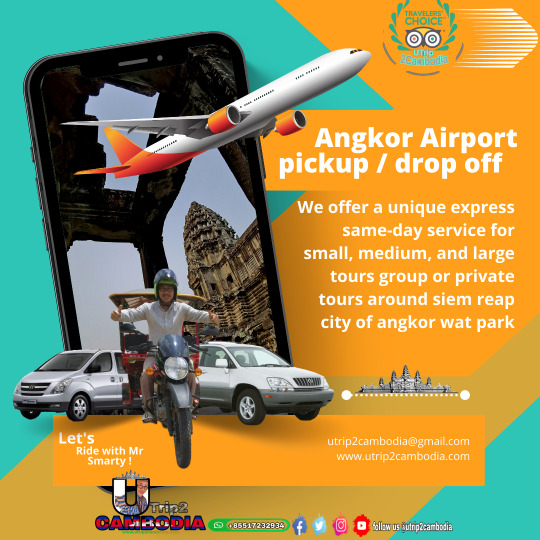

siem reap taxi / tuk tuk driver, angkor wat tuk tuk /driver, cambodia tuk tuk / services, angkor best tuk tuk driver, siem reap best tuk tuk tour,
https://www.tripadvisor.com/Attraction_Review-g297390-d18841022-Reviews-U_Trip_2Cambodia-Siem_Reap_Siem_Reap_Province.html
https://www.tripadvisor.com/Attraction_Review-g12591811-d25072884-Reviews-Angkor_Best_Tuk_Tuk_Driver_By_Mr_Smarty-Svay_Dangkum_Siem_Reap_Siem_Reap_Provi.html
Angkor archaeological site. Roluos Group Temples: Preah Ko, Bakong and Lolei.Victory Gate of Angkor Thom Bayon. Baphuon, Royal Enclosure, Phimeanakas, and Elephant Terrace and Leper King Terrace. Preah Khan temple, Neak Pean Temple, Mebon and Pre Rup temple
#siemreaptuktukdriver #angkortuktukdriver #cambodiatuktukdriver #utrip2cambodia #angkorsmartydriver #templetour #siemreaptransport #taxitotemple #mrsmarty #floatingvillagetour #bengmealeatempletour #banteaysreytempletour #kohkertempletour #tuktukdriver #kulenmountiantour #sunrise&sunsettour #siemreptour
-------------------------
WhatsApp & Telegram:(+855)17 232 934
Line ID: siemreapcambodiataxi
WeChat ID: AngkorSmartyDriver
-----------------
Taxi Bookiing :
Siem Reap <> Phnom Penh
Siem Reap <> Battambong
Siem Reap <> Poi Pet Border
Siem Reap <> Preah Vihear
Siem Reap <> Steng Treng
Siem Reap <> Anglong Veng
Siem Reap <> Sihanuk Vile
Siem Reap <> Kampot/Kep
--------------------
Phnom Penh <> Kampot/Kep
Phnom Penh <> Sihanuk Vile
Phnom penh <> Koh Kong
Phnom Penh <> Battambong
Phnom Penh <> Mundol kiri/Ratanak Kiri
---------------------------
https://www.tripadvisor.com/Attraction_Review-g297390-d18841022-Reviews-Cambodia_Angkor_Smarty_Driver_Tours-Siem_Reap_Siem_Reap_Province.html
https://www.tripadvisor.com/Attraction_Review-g12591811-d25072884-Reviews-Angkor_Best_Tuk_Tuk_Driver_By_Mr_Smarty-Svay_Dangkum_Siem_Reap_Siem_Reap_Provi.html
0 notes
Text
Preah KO temple
Welcome to Siem Reap Cambodia following bye Polin TukTuk Drivers Tours:
1: pick up you from hotel at 8:00am to visit Small Tours: Angkor wat,Prasat Kravan temple Banteay kdey srasrong and lunch time at local restaurant.
Ta Prom thomrider temple Takeo Thommanon Chaosay Tevada victory gate Angkor Thom Bayon temple Baphoun temple and sunset Angkor wat,or the hill
2: Pick up you from hotel at 4:50am to visit sunrise at Angkor wat, and Big Tours:Preah khan Neak pean Tasom East Mebon Tasom Prea Rup lunch time local restaurant
Banteay srie , Banteay samre
3: Kompong plouk floating forest tonle sap lake and the Rolouse group Bakong Preah KO,lolei
Feel free time contact me: WhatsApp:+85512522431 line, Telegram
Email [email protected]

1 note
·
View note
Text
Angkor temples
Probably the single most impressive place I visited in South-East Asia during my five week trip back in 2013, Angkor was quite incredible, the largest pre-industrial city in the world. Thankfully I had three days there, exploring Angkor Wat, Ta Prohm, and nine other temple complexes covered here. Bayon is the newest major Angkor temple, built at the end of the 12th century. It is famous for it’s…

View On WordPress
#Angkor#Angkor temples#Angkor Thom#Banteay Srei#Baphuon#Bayon#Cambodia#East Mebon#Neak Pean#Phnom Bakheng#photography#Pre Rup#Preah Khan#travel
6 notes
·
View notes
Text

2 notes
·
View notes
Photo

Neak Pean pond, Angkor, Cambodia
62 notes
·
View notes
Text
Living Vicariously Through the Naga:The Enigma Lives On in Siem Reap…
by: Genie
Ensconced in the rainforest and steeped in centennial mythology, lies the province of Siem Reap, home to the variegated archaeological extravaganza embodied by Angkor, the old seat of the Khmer Empire. Once shrouded in mystery, this verdant area is dotted far and wide with architectural wonders, however a particular quartet of magisterial temple complexes, open to the public today, accounts for much of its widely deserved mystique: Angkor Wat, Angkor Thom, Preah Khan and Ta Prohm.
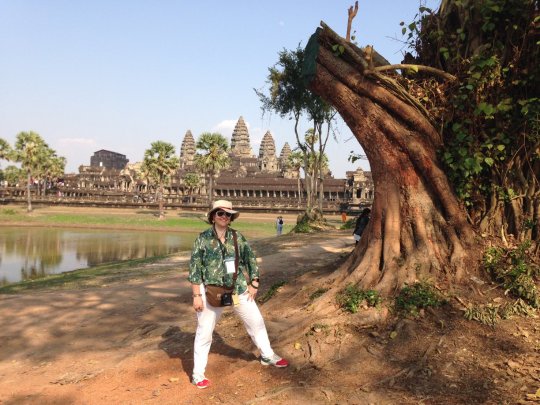
The historical promenade through Cambodian history could not begin at a better place than Angkor Wat. After a brisk, vertiginous walk over the frontal moats and their tall lily pads by way of the “floating” bridges, Angkor Wat starts etching its “mountainous”, verdigris contours on the horizon, in all its pomp and pageantry. Some tall palm trees here and there, wandering rhesus monkeys, endless meters of loggias reflecting over the water, and monks clad in orange walking back and forth, act as merely the castellated gateway and battlements to King Suryavarman II’s main, multi-story building and its five signature turrets set against a perennial twilight sparkle.
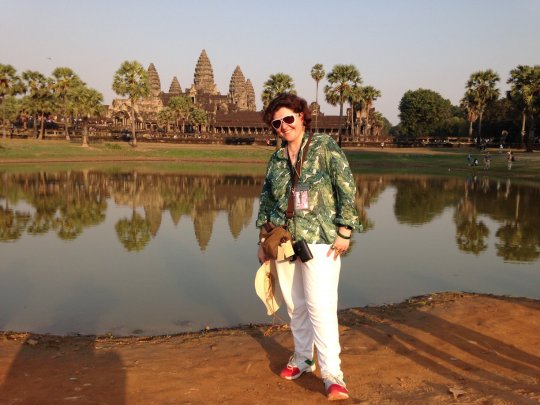
Given the magnitude of this World Heritage structure, it would take more than one afternoon to visit it properly. Suffice it to say, to this day Angkor Wat is the largest standing religious building in the world. Still and all, its essence is to be found primarily in a threefold enigma. First of all, it is per se rather puzzling that Angkor Wat should be originally consecrated to none other than the Hindu divinity Vishnu. Today, Angkor Wat is both Hindu and Buddhist, but considering that Hinduism is not as geographically widespread as Buddhism from India eastwards and that it is an older religious philosophy, it begs a more in-depth question as to what exactly happened. Hence, the (originally and equally) Hindu Ko Samut Teuk Dos legend, also known as Samudra manthan (in Hindi); in other words, The Churning of the Ocean of Milk.
According to this founding epic, Devas (Gods) and Asuras (Demons) were forever at war to dominate the world. Ever more tired and running out of strength, the Devas asked Vishnu for help. As a token for his help, Vishnu asked the Devas to search for Amrita, the Sacred Elixir of Immortality, from the depths of the cosmos. However, because the task was so difficult, the Devas were forced to ally with their antagonists, the power-voracious Asuras. Using Mount Meru as the pivotal point and the King of the Nagas (snakes), Vasuki, as a churning device, both factions placed themselves at different extremities of the Naga and started pulling, while many treasures emerged from the Ocean of Milk. In time, the Asuras, being closer to the head of the Naga, were eventually poisoned by the fumes it exhaled, only managing to save themselves when Amrita was delivered to them by a divinity emerging from the Ocean of Milk. This episode did not go unnoticed by the Devas; they promptly informed Vishnu, who managed, in turn, to steal back Amrita and hand it to the Devas, so that they could reign supreme and banish the Asuras to hell.
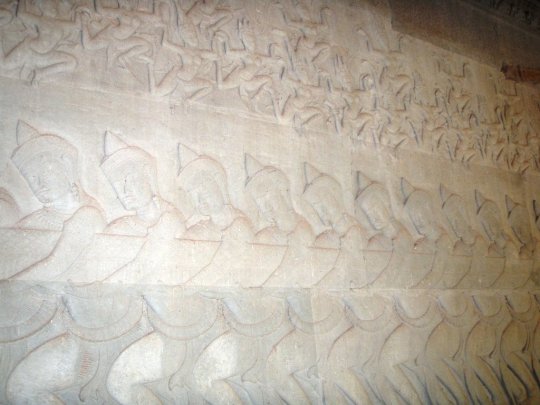
This legendary tale represents the second enigma of Angkor Wat, and is virtually “unlocked” in the impossibly beautiful bas-reliefs stretching along the 49 meters of the east gallery, a grand spectacle where what could have been remnants of muted pink, ochre, and terra-cotta hues can still be slightly discerned by the naked eye between carvings. Also unlocked within Angkor Wat is the third enigma, whereby a Naga princess wed the First King of Ancient Cambodia, giving rise to the Cambodian people or Khmer. In this respect, Angkor Wat has various massive balustrades in the shape of the seven-headed Naga, each head representing the seven “races” of the Naga people. A recurring theme in the Angkorian temples, the seven-headed Naga is part and parcel of Khmer cosmology, as are the Apsaras, the celestial dancing creatures whose main purview included entertaining royalty and divinities on earth with their perfunctory expressions.

The hypnotic tour through Khmer chronology continues between Angkor Wat and Angkor Thom, where a short pit-stop to the Baksei Chamkrong temple gives us a taste of what would seem to be yet another enigma. According to various “conspiracy” theories, there are uncanny stylistic similarities between the Mayan Pyramid of the Great Jaguar (in Tikal, Guatemala) and Baksei Chamkrong! Clearly, the knowledge and discoveries acquired thus far on the matter are not enough to reframe history, so to say; nonetheless this testament to the universal aspect of human imagination makes for some quite fascinating journeys!
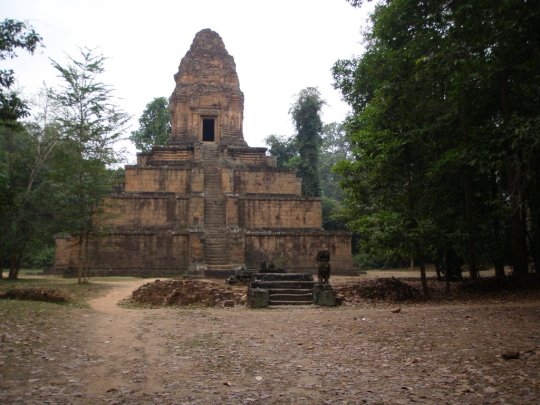
On its part, Angkor Thom, the last capital city of the Khmer Empire, boasts a masterpiece triad of its own, the first of such being King Jayavarman VII’s exquisite 350-meter long Terrace of the Elephants. Once a royal platform to salute his military forces, this terrace features intricate carvings of lions, elephants and Garudas, the bird-like creatures pertaining to Hindu, Buddhist and Jain mythology, and stalwart nemesis of the Nagas. Located just off the Royal Square is the Terrace of the Leper King. Although there was a king with leprosy in Cambodian history, the name derives mainly from the erosion found on the statue of Yama, the God of the Underworld, carved within this site. This terrace might have been used for funerary/cremation rites.
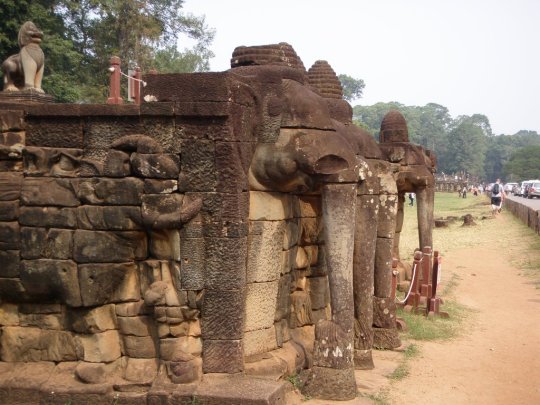
Perhaps the most distinctive temple in Angkor Thom is the “baroque” Prasat Bayon. Entering through the South Gate, one is confronted with nothing short of yet another enigmatic vision, as 200 towering giant faces (four per tower) look down on you with their seraphic smiles and sphinx-like countenances. Although it is unclear whether the faces depict Lokesvara (the Buddhist bodhisattva of compassion) or King Jayavarman VII, the two hypotheses do not necessarily exclude each other. While the bas-reliefs within the temple, portraying military scenes and other mundane events, are also worthy of note, the deeply rooted “intimidation/awe” deriving from the “scoping stares” remains the main highlight of the Bayon. For all we know, they might have been –and still are- quite a bulwark against the evil eye, if anything!
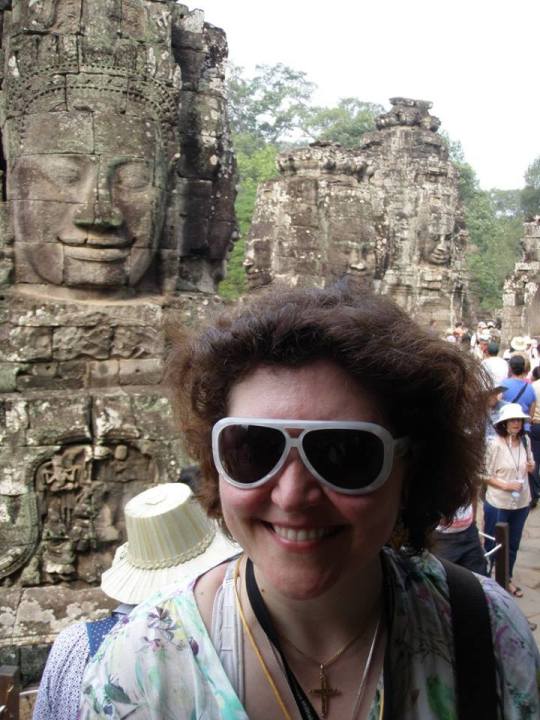
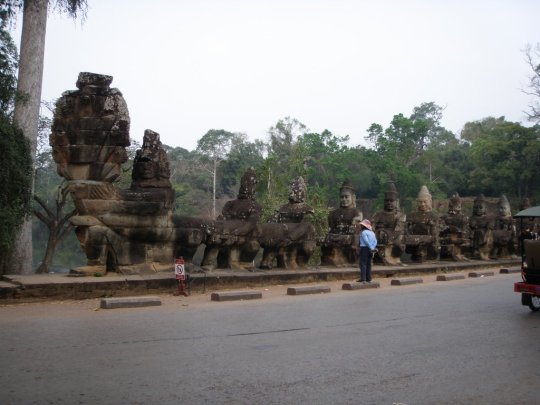
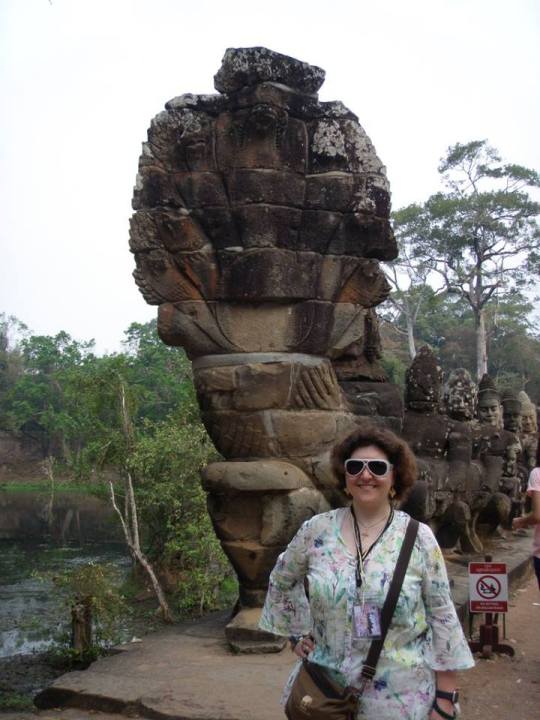
The eternal voyage of the Naga continues in the Neak Pean and Preah Khan temples, located north of Angkor Thom. Upon first impressions, and having to cross a long walkway on swampy waters before reaching the former, it is hard to believe that there might be a temple at the end of the glittering trail. However, Neak Pean juts out from a central sacred pool (believed to represent the mythical Lake Anavatapta and to have healing powers), surrounded by two “underwater” sculptures of the Naga. As regards the latter temple, it is the proof that nature (usually) claims –or ravages, in this case- back its own! At any rate, not even this inevitable and “vengeful” predicament has managed to cover up the ineffable magic of Preah Khan, home to Jayadevi (a sister-wife of King Jayavarman VII), among others. Moss, lychen and ferns slowly brush over the rubble and rickety beams framed by quasi-trompe l’oeil flourishes, while a vast array of delicate carvings, reliefs and friezes, not to mention the standing library ruins and stupa illuminated by the sun, complete this eerie, albeit paradoxically idyllic, setting on the green.

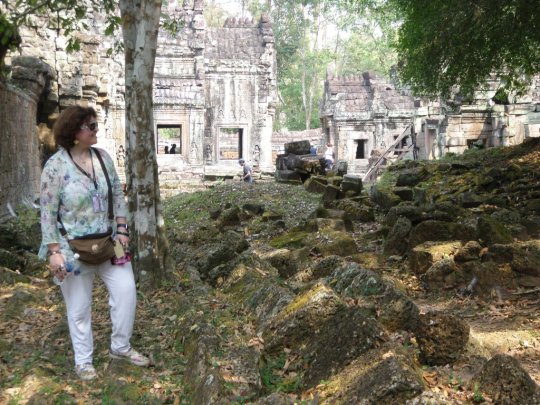
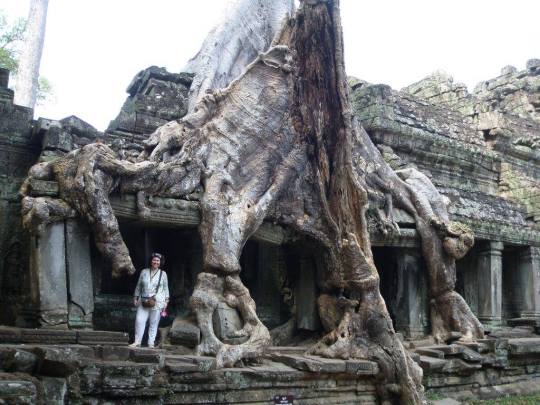
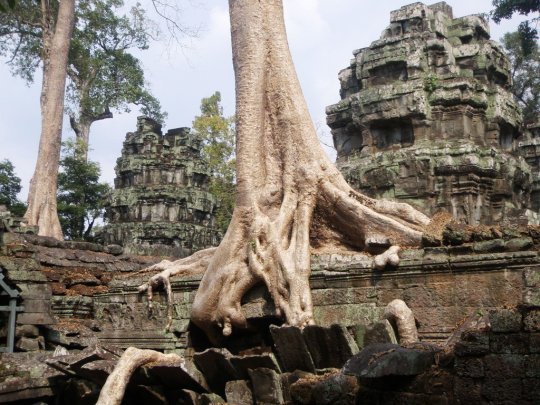
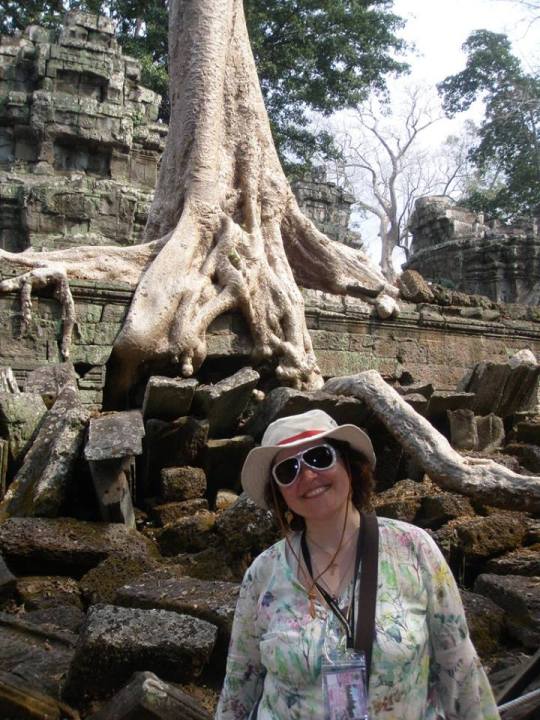
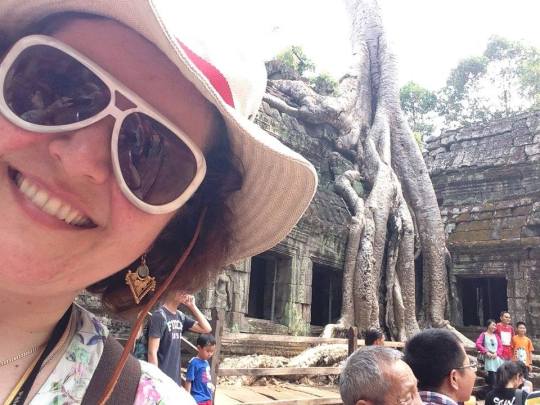
The encroaching nature and weathered look of Preah Khan, however, is solely a prologue to the real devouring power of the forest subsequently witnessed at Ta Prohm, the culminating phase of this open-air museum survey. As soon as Ta Prohm’s ruins are approached, the elusive footpaths give way to a stunning portrait of luxuriant foliage and creeping vines that lift as if they were deep-green shutters following each occasional waft of wind. Here, the Nagas and Apsaras have relinquished their leading roles to the true main protagonists, tetramelacea (tetrameles nudiflora), ficus strangulosa and ceiba pentandra (kapok), names that, given their peculiarity, would seem those of gods, but actually refer to gigantic trees. Their imposing barks have literally taken over the temple complex, coiling up the ruins like the Nagas themselves… or is it that the trees are living vicariously through the Nagas and viceversa? Alas, not even Lara Croft could have possibly deciphered this last enigma, bound to live on for the centuries to come! But, like Lara Croft’s alter-ego, we shall return…
Rome, 5 March 2019
#cambodia#viaggidellelefante#khmerempire#khmertemple#siemreap#angkor#angkorwat#angkorthom#baksei chamkrong#neak pean#prasat bayon#preah khan#ta prohm#apsara#naga#vasuki#samudra manthan#lara croft#tombraider#tomb raider#kapok#tetramelacea#suryavarman#jayavarman#jayadevi#anavatapta#terrace of the elephants#terrace of the leper king#garuda#hindu
12 notes
·
View notes
Text
Siem Reap Taxi Driver, Phnom Penh to Siem Reap, Taxi Siem Reap to Angkor temples, Minivan taxi driver in Cambodia
One day trip to Angkor Wat temple, Preah Khan temple, Neak Pean temple, Ta Sam temple, East Mebon temple & Pre Rub temple.
WhatsApp +85569467474 https://www.exclusivecambodiatravel.com/
0 notes
Text
Some fantastic vistas! These sort of oblong coaster slices looked like the perfect cameos for these scenic views


#yarrisharts#neak pean#Machu Picchu#athens acropolis#scenic vistas#archaeology#sketches#work in progress
9 notes
·
View notes